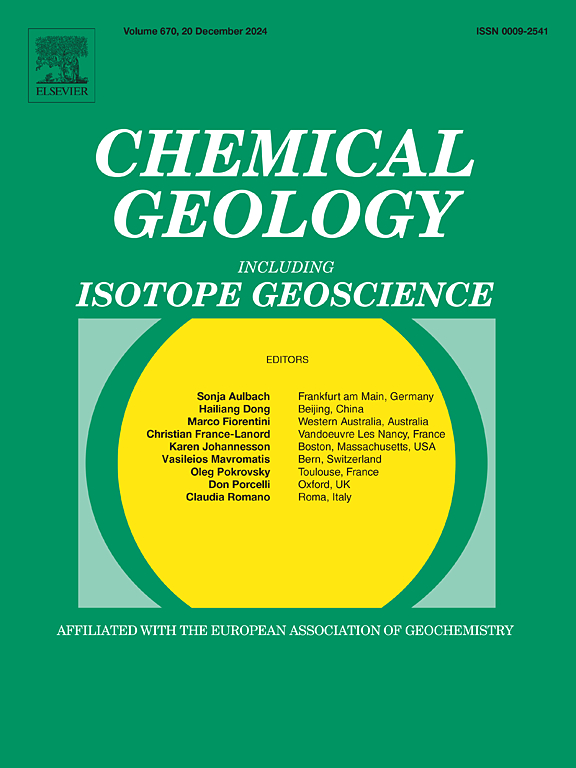Hydrothermal solubility of Dy hydroxide as a function of pH and stability of Dy hydroxyl aqueous complexes from 25 to 250 °C
IF 3.6
2区 地球科学
Q1 GEOCHEMISTRY & GEOPHYSICS
引用次数: 0
Abstract
The rare earth elements (REE) have important applications in green energy technologies. The formation of mineral deposits in geologic systems commonly involves hydrothermal fluids which can mobilize the REE. However, the REE speciation is not well known as a function of pH. The thermodynamic properties of REE hydroxyl complexes used in geochemical models are based on the Helgeson-Kirkham-Flowers (HKF) equation of state parameters which were derived by extrapolation of low temperature experimental and estimated data. In this study, Dy hydroxide solubility experiments are combined with available literature data to improve these models from 25 to 250 °C and optimize the thermodynamic properties of Dy3+ and Dy hydroxyl complexes using GEMSFITS. Batch-type solubility experiments were conducted from 150 to 250 °C and at saturated water vapor pressure in perchloric acid solutions with initial pH values of 2 to 5 in 0.5 pH unit increments. The measured solubility of Dy hydroxide is retrograde with temperature and decreases with pH. The logarithm of total dissolved Dy molality ranges from −2.3 to −5.3 at 150 °C (pH 4.7–5.5), from −2.4 to −5.6 at 200 °C (pH 3.9–5.1), and from −3.7 to −6.9 at 250 °C (pH of 3.4 and 5.0). The optimized standard partial molal Gibbs energies of formation (∆fG°T) derived for Dy3+ and DyOH2+ display a close to linear relationship with temperature, fitting with previous optimizations based on DyPO4 solubility data in the literature. A comparison of the optimized ∆fG°T values for aqueous Dy species with predictions from available HKF parameters indicates significant differences ranging from +11 to −26 kJ/mol between 25 and 250 °C. The experimental fits are used to derive the Dy hydroxide solubility products (Ks0) and formation constants for the hydrolysis of Dy (βn with n = 1 to 3; Dy3+ + nOH− = DyOHn3-n) as a function of temperature. The optimization method presented yields accurate thermodynamic properties for the Dy3+ aqua ions and the DyOH2+ species at the acidic to mildly acidic pH studied whereas more experimental work is needed at near-neutral and alkaline conditions to better constrain the other hydroxyl complexes. The optimized thermodynamic data have a significant impact on geochemical modeling of the mobility and solubility of REE minerals in acidic hydrothermal fluids.
氢氧化镝的水热溶解度随pH值的变化及其水溶液配合物在25 ~ 250℃间的稳定性
稀土元素在绿色能源技术中有着重要的应用。地质系统中矿床的形成通常涉及热液流体,热液流体可以调动稀土元素。地球化学模型中使用的稀土羟基配合物的热力学性质是基于Helgeson-Kirkham-Flowers (HKF)状态方程参数,该方程参数是通过低温实验和估计数据的外推得到的。在本研究中,我们将氢氧化镝溶解度实验与现有文献数据相结合,在25 ~ 250°C范围内改进了这些模型,并利用GEMSFITS优化了Dy3+和Dy羟基配合物的热力学性质。在初始pH值为2 ~ 5的高氯酸溶液中,以0.5 pH单位增量,在150 ~ 250℃和饱和水蒸气压下进行批量溶解度实验。氢氧化一的溶解度随温度的升高呈逆行关系,随pH值的升高而降低。在150℃(pH值为4.7-5.5)时,溶解的总Dy摩尔浓度的对数范围为- 2.3 ~ - 5.3,在200℃(pH值为3.9-5.1)时,对数范围为- 2.4 ~ - 5.6,在250℃(pH值为3.4和5.0)时,对数范围为- 3.7 ~ - 6.9。优化得到的Dy3+和DyOH2+的标准偏摩尔吉布斯生成能(∆fG°T)与温度呈近似线性关系,与文献中基于DyPO4溶解度数据的优化结果吻合。将优化后的水溶液Dy的∆fG°T值与可用HKF参数的预测值进行比较,表明在25°C和250°C之间的差异在+11到- 26 kJ/mol之间。利用实验拟合得到了Dy (βn)在n = 1 ~ 3条件下水解的溶解度产物Ks0和生成常数;Dy3+ + nOH−= DyOHn3-n)作为温度的函数。所提出的优化方法对Dy3+水合离子和DyOH2+在酸性至微酸性条件下的热力学性质有准确的预测,而在近中性和碱性条件下,需要更多的实验工作来更好地约束其他羟基配合物。优化后的热力学数据对酸性热液中稀土矿物迁移性和溶解度的地球化学模拟有重要影响。
本文章由计算机程序翻译,如有差异,请以英文原文为准。
求助全文
约1分钟内获得全文
求助全文
来源期刊

Chemical Geology
地学-地球化学与地球物理
CiteScore
7.20
自引率
10.30%
发文量
374
审稿时长
3.6 months
期刊介绍:
Chemical Geology is an international journal that publishes original research papers on isotopic and elemental geochemistry, geochronology and cosmochemistry.
The Journal focuses on chemical processes in igneous, metamorphic, and sedimentary petrology, low- and high-temperature aqueous solutions, biogeochemistry, the environment and cosmochemistry.
Papers that are field, experimentally, or computationally based are appropriate if they are of broad international interest. The Journal generally does not publish papers that are primarily of regional or local interest, or which are primarily focused on remediation and applied geochemistry.
The Journal also welcomes innovative papers dealing with significant analytical advances that are of wide interest in the community and extend significantly beyond the scope of what would be included in the methods section of a standard research paper.
 求助内容:
求助内容: 应助结果提醒方式:
应助结果提醒方式:


